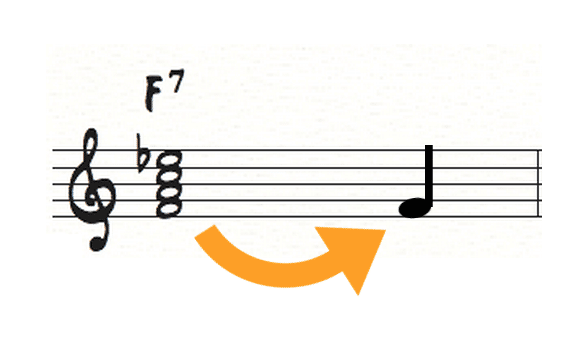You’re waiting by the stage. In a few moments it’ll be your turn to walk into the spotlight to take a solo. And your heart is beating a mile a minute. But there’s just one problem – you don’t know the key of the song and you don’t know the chords. All you know is that you need to start your solo as soon as the melody ends…
You keep thinking “Can I pull this off?” Well it all depends on one question: How good are your ears?
It’s one thing to talk about ear training and connecting your ears to your instrument.
…but it’s another thing entirely to get on stage with the confidence that you can hear anything that comes your way.
Sure, you might have an ear training class under your belt and you may be able to identify each interval on a quiz, but are you ready to start improvising with your ear alone?
Most players have never asked themselves this question and they get the answer at the worst possible time: on stage in front of an audience.
So think about your own ears – would they pass the test in live performance?
Don’t wait until it’s too late to find out…
Let’s start with a test
Take the tune Trane’s Blues from the Miles Davis album Workin’.
Here’s your test:
- Press play on the video below
- Listen to the melody until Miles solo starts (:20 sec)
- Now sing the root of each chord.
Without knowing the key or using an instrument, you have to sing the root of each chord using just your ear.
Here we go…
Could you do it?
It’s harder than it sounds
It sounds like an easy exercise (I mean it’s just the root!)…
But the truth is that many musicians struggling to improvise can’t do this exercise. It’s one thing to test an interval in the classroom or to listen to one chord at a time.
However, that’s not how you encounter these sounds in the real world.
In live performance there is a rhythm section with walking bass lines, moving chords and interactive time. There are horn players playing the melody and soloing…
And everything hits your ear at once.
To be a successful soloist your ear has to be at the level where you can pick out the most important information right away. You can’t hide behind your instrument and music theory.
You can’t press a button and have the note automatically come out or use a scale to ensure that you’re playing the right notes. When you’re singing everything depends on your ears.
You actually have to hear the note or chord tone in your head and you have be able to produce that sound with your voice. This is what it means to have good ears.
Now here’s how you’ll get there
You may have only one chance to hear the chord progression or melody in a performance, but here’s the good news…
In the practice room you have as much time as you need. And if you focus on the right things your ear will improve faster than you think.
For the test above, it all starts with knowing what the root sounds like on each chord.
This isn’t an intellectual exercise or a theory exercise, it’s a sound that you need to have ingrained in your ear.
Since we are dealing with a blues, let’s start with the sound of the root on a V7 chord.
Step one is ingraining the distinct sound of the root in your ear. Take a listen the this track:
- Close your eyes and focus on the sound of the root
- Can you hear the chord tone in your mind?
- Now listen to it one more time and this time you’re going to sing the root along with the recorded example
The root has the same sound in any key. You must ingrain it in your ear. Your goal is to be able to identify and sing this sound wherever you encounter it.
Test your ear on a blues chord progression
So let’s go back to that 12 bar blues progression.
We’re going to focus on the root of each chord in the basic blues progression. It’ll look like this written out on the staff:
Now that you have the sound of the root ingrained in your ear and you can sing it, it’s time to try singing along with a simple blues progression – chords only:
- Try hearing the root in your mind without singing
- Sing the root of each chord along with the background track
- Now try it one more time with the “jazz blues” chord progression:
Now let’s go back to the original recording.
Remember when you’re performing everything isn’t laid out neatly for you. There are other instruments playing, melodies, counter melodies, harmonies, etc.
You’re ears have to be strong enough to find the notes you’re looking for:
If you’re still having trouble finding the root, go back to the previous exercises until you have the sound of the root ingrained in your ear.
Want more ear training exercises like this?
So where do you go from here?
Now the trick is to do this exercise with every chord tone…on major chords, minor chords, V7 chords and half-diminished chords.
This way your ears will be prepared for any sound that you’ll encounter as an improviser.
And we’re excited to offer a program that will finally help you do this!
Inside the The Ear Training Method we’ll show you how to:
- Master each chord tone on Major, minor, V7 and half diminished chords
- Ingrain and test every interval from minor 2nds all the way to major 7ths
- Hear multiple intervals in a row
- Identify the specific chord voicings that you’ll encounter in the real world
- All over the course of 300 audio tracks that you can listen to anywhere
Everyone can stand to improve their ears
Your ears aren’t just crucial for performance, they’re an essential ingredient in your daily practice.
Great aural skills improve your ability to learn tunes by ear and transcribe solos and allow you to listen to and identify the parts of your favorite songs.
You might’ve found the test above challenging or maybe it was a piece of cake – it doesn’t matter. Every musician should be striving to hear even more with their ears.
If you start improving the level of your ear today, every aspect of your practice and performance will become easier.
Remember, when you get put on the spot you don’t want to be thinking about note names and scales. You want to close your eyes and hear exactly what you want to play.














